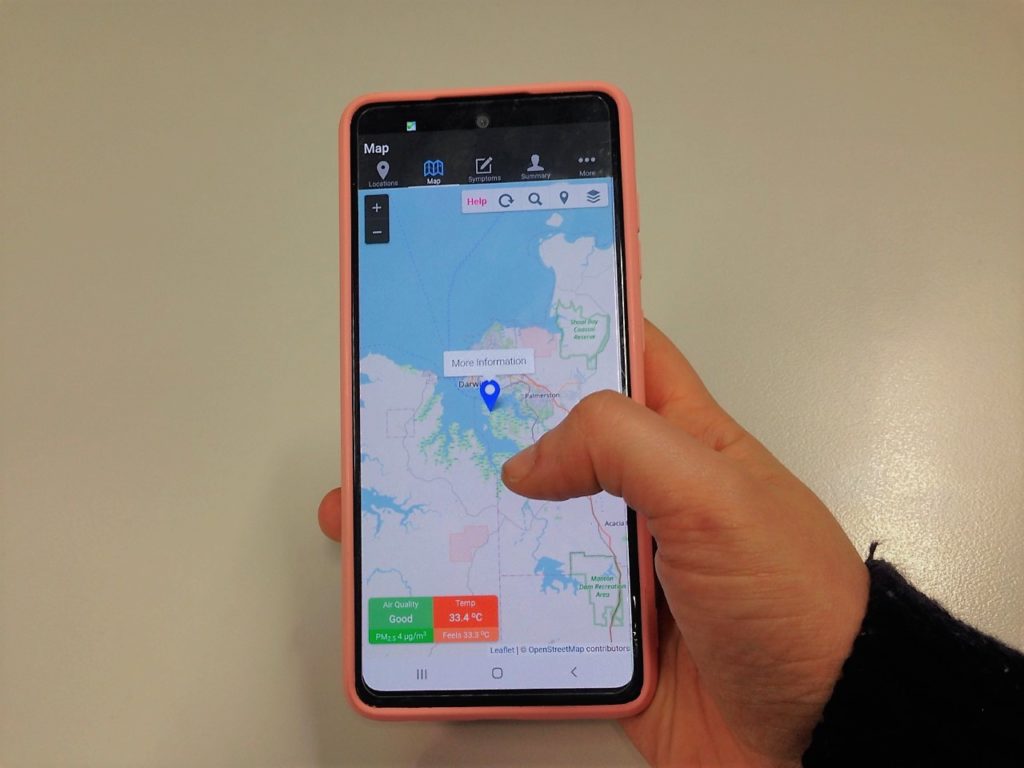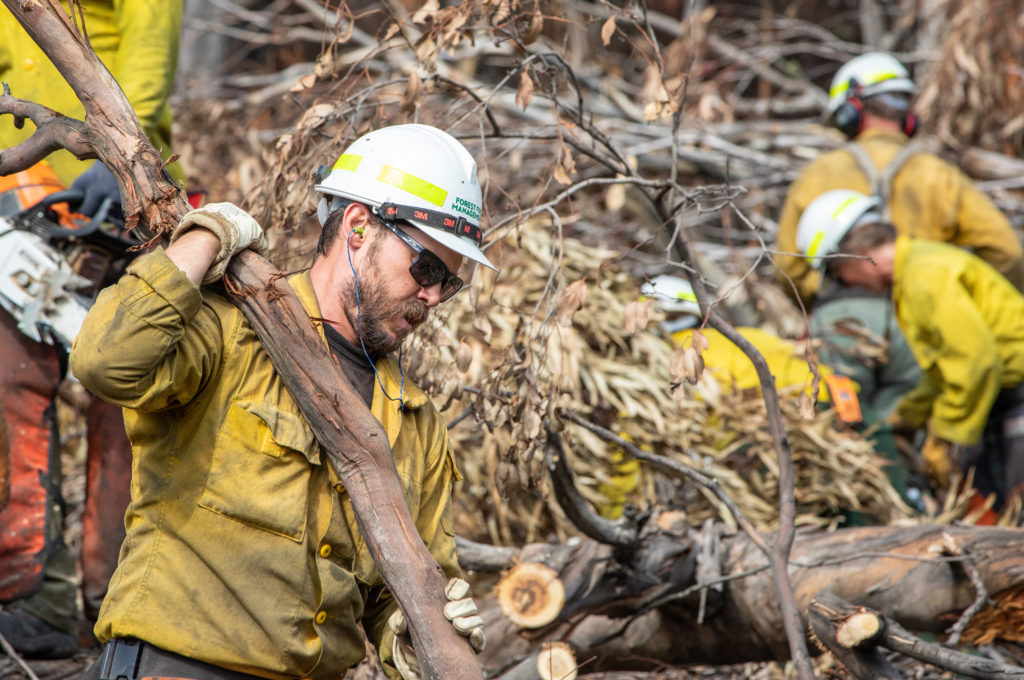Imagine being a concreter during a Darwin summer. Or working on a tin roof when it’s more than 35°C and 80 per cent humidity. High temperatures and humidity can have a major impact on our health, even leading to life-threatening emergencies.
We’re partnering with the University of Tasmania on a new project that will help Darwin’s outdoor workers find ways to better manage working when it’s hot.
Hot (and humid) in the Darwin heat
The future looks hot for Darwin. The city is already experiencing the same number of hot days that scientists thought we’d see in 2030. Darwin has around 11 days a year above 35°C. But in 30 years’ time, this could increase to between 111 and 172 days, according to our research. We’ve also mapped the hot spots for Darwin and how that relates to health impacts.
But in the Top End, it’s not just the temperature. Humidity can be extremely high, more than 95 per cent in the build-up and wet season. In these conditions, the body’s natural cooling mechanism (sweating) just doesn’t work. It means the Darwin heat often feels hotter than the temperature suggests. And this can be bad news for our health.
Along with heat and humidity, air pollution and other environmental conditions can also make you sick. Air quality can be poor when there is a lot of smoke in the air from burn-offs or bushfires. Air quality can be bad when temperatures are high, so they often go together.

AirRater helps people working outdoors, including construction workers and builders, to better manage their occupational heat stress.
Who is most at risk?
For outdoor workers, extreme heat, humidity and air pollution pose real health and safety risks (as well as affecting productivity).
Occupations at risk of poor health in these conditions include those in the building industry, fisheries and agricultural workers, gardeners and landscapers, rangers, community health workers, emergency services, transport workers and those working in the oil and gas industry.
For somewhere like Darwin, this really includes anyone who works outside in an uncooled environment. Like a non-airconditioned manufacturing workshop. And for some professions, the personal protective equipment (PPE) necessary for their work can make things even worse.
People with existing illnesses, like asthma, allergies, and hay fever, are especially vulnerable.
Heat events and severe air pollution are linked to increases in ambulance call-outs, hospital admissions and death. For someone with a heart condition, if they are working outside in the sun and not properly hydrated, an increase in blood pressure may lead to increased strain on the heart, leading to a serious event like a heart attack. Exposure to extreme heat can also exacerbate diabetes (through fluid imbalance) and can cause acute and life-threatening events like heat stroke. It can also cause chronic issues like headaches and fatigue. High temperatures are also linked to increases in ozone, which is a trigger for asthma.
So, what can we do?
AirRater: environmental data at your fingertips
AirRater is a free smartphone app created by a team at the Menzies Institute for Medical Research at the University of Tasmania.
The app was designed to support people to reduce the health impacts of environmental conditions, such as extreme heat and poor air quality.
If you live in Darwin you can download AirRater for free and get up-to-date information about the air quality near you (Image – UTAS).
Launched in October 2015, AirRater originally operated in Tasmania, then the Australian Capital Territory and the Northern Territory. Its use rapidly increased across Australia during the Black Summer bushfires in 2019-20. At this time, more than 80 per cent of Australians were exposed to extreme temperatures or long periods of smoke.
AirRater aims to help people better manage symptoms related to heat and poor air quality, and improve their quality of life.
The app tracks temperature and air quality and helps you directly link that information back to your health. When you download the app, you can enter your symptoms (like headache, fatigue, muscle cramps, sneezing, or shortness of breath). The app then records the environmental conditions where you are. Over time, once you enter enough symptoms, AirRater builds up a picture of what conditions trigger your symptoms. Once the app has worked out your triggers, it sends you notifications when those triggers are elevated in your location. For instance, if extremely hot weather is on the way, it will send you a warning.
At the same time, the app gives you up-to-date information about air quality (smoke, pollen, temperature, and humidity) right around Australia, where those monitoring stations are available.
A cool app for tropical tradies: Inviting Darwinians to use AirRater
You can already use AirRater in Darwin. Now we want to find out more about how outdoor workers can use the app to help manage extreme heat and humidity.
The project is a partnership between the Darwin Living Lab (a collaboration between us, the Australian and Northern Territory governments, and the City of Darwin) and the Environmental Health research team at the University of Tasmania. The study is led by Dr Sharon Campbell.
“We’re keen to find out how extreme weather conditions affect outdoor workers in Darwin, especially before serious health consequences start to show up,” Sharon said.
“We can also start to help workplaces better plan and manage for extreme conditions into the future.”
Dr Erin Dunne, an atmospheric scientist who grew up in the Darwin heat, is leading our share of the work.
“We want people working outdoors in Darwin to look after their health,” Erin said.
“And we want to know how AirRater can help Darwin’s outdoor workforce to better manage their risk of occupational heat stress.”
Emergency services workers are one of the groups at risk of extreme heat, humidity and air pollution in Australia (DOI Neal Herbert).
What will you get out of the project?
The project will support tradies and other workers to make decisions about working in extreme heat and humidity.
Anyone who spends most of their work time outdoors is welcome to join the project. We’re recruiting people in August and September 2021.
We’re asking people to download the AirRater app and enter their symptoms, from October through to March. It takes less than a minute to enter your symptoms.
In turn, you will get access to localised, real-time, and easy-to-use data on temperature, humidity and air quality from the Northern Territory EPA sites. You’ll also get advanced warnings of extremes in temperature and poor air quality.
Having this information in the palm of your hands will help empower you to take action to reduce your exposure to these conditions, to be well-prepared, and to look after your health. For example, during the Black Summer bushfires, waterfront workers in Newcastle and Sydney used the app to help manage their exposure to the smoke.
You’ll also be helping to make your workplace safer for everyone.
“The more users we have, the better the data, and the better we can protect people’s health,” Sharon said.
“Once we have more data, we’ll be able to provide guidance for workplaces to improve their policies. For instance, is there a tipping point of temperature and humidity when people really begin to show symptoms? We hope to find out more about that.”
The year-long project is connected to the broader work by the Darwin Living Lab. We’re finding innovative ways to improve the way we live, learn, work, and play in our unique tropical capital.
Curious? Give it a hot go!
AirRater is available for Android devices through Google Play and iOS devices (iPhone and iPad) through the App Store.
Ready to help us monitor the Darwin heat? We’re keen to hear from anyone working outdoors or in a non-airconditioned environment, including:
- Tradies
- Construction workers – especially those people working on rooves, roads, bridges, and buildings
- Fisheries and agricultural workers
- Emergency services workers
- Rangers
- Environment field workers
- Inspectors
- Garden landscapers
- Community health nurses
- Solar installers
- People working outdoors in the oil and gas industries
- Transport workers – road, rail, and sea
You can join the study by emailing air.rater@utas.edu.au. We’d love to hear from you.
You can also join our free webinar about the project on 26 August from 3.30-4.30 ACST (4-5pm AEST).
The Darwin Living Lab is a 10-year collaboration between us, the Australian Department of Infrastructure, Transport, Regional Development and Communications, Northern Territory Government, and the City of Darwin.

